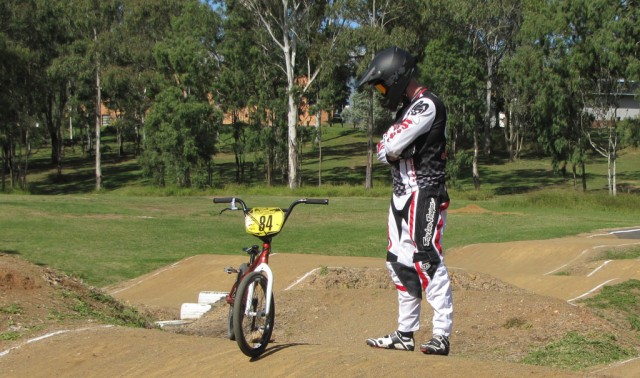Bruce’s BMX Babblings: Risk versus Reward – Coming back to BMX racing after 30
BMX racing can be tough on the body at any age, but especially after 30 when the body’s components don’t repair at the rate they did when you were 20. When you’re over 40, any crash results in you laying there for a moment checking the body’s systems like Han Solo checking the Millennium Falcon after a brush with the Imperial Forces. With this racer approaching 50, well, is it pure folly to pursue this sport? Or should I join the Nerang Bowls Club next year rather than join the Nerang BMX Club with Debbie Lockwood and her crazy chilli chicken wrap crew?

The reason I’m asking myself this question is a combination of seeing a fair few mates spend time in the hospital over the past couple of years with injuries akin to MX accidents, and, dealing with my own anxieties from a crash (with associated head trauma) in 2015 six weeks out from the national titles at Sleeman where, whilst sitting in staging before the first moto, I nearly pulled the pin as we waited for the 4 ambulances lined up to be filled with bodies. Not so comical was the poor dude who, already suffering from his crash, was tipped off his stretcher right in front of us! “What’s wrong with me”? I asked myself. Why did I feel this way? After all, I hadn’t crashed at Sleeman. Had I lost the “right stuff”?
Seeing my mates taking such a long time to recover to normal functionality, let alone return to racing, has been hard. Some never return, some do. I mean, I’ve been riding motorcycles for nearly 35 on the road and have not once visited a mate in hospital as a result of a crash, but BMX, more than a handful in the past few years. How’s that possible?
What fuels my anxiety? Do my fellow riders share the same feelings? I know from my role as a coach looking after specifically 30+ year old riders, that I wasn’t alone as they too expressed more than just pre-race nerves at the recent Queensland titles held at Sleeman. The track certainly ramps up this anxiety. It’s not particularly difficult, but the first two jumps can bite hard if you get them wrong.
The types of injuries we are seeing in this era in the older riding age groups just haven’t been a few fractured collar bone, but multiple rib fractures, punctured lungs, vertebrae fractures, along with head trauma. Internal injuries like tears of organs/lacerated livers are akin to hitting a steering wheel at 50kph without a seatbelt according to the staff at a Gold Coast hospital who were treating my mate Shaun. My last visit to Ward 4 at the PA Hospital here in Brisbane to visit a fellow rider a few weeks back led to a comment from staff member on the floor when I asked for the room: “oh yeah, the BMX guy. We see a few of these”
So what gives? So many questions….
Is it the tracks? Is it the lack of skill? Being clipped in? The intensity of the competition? Or is it because our older bodies simply cannot cope with the type of falls that younger riders just seem to brush off? I pose the question to a Facebook page I kicked off around 2 years ago: What’s causing these magnitude of injuries? Is it a real, or an imagined issue of my own making? I invited people to share their stories, feelings, both by commenting, or by messaging me if they didn’t feel comfortable sharing publically.
A closed group made up of over 800 “adults”, most of who are actively riding/racing, or who are parents of racers, I made it clear I wasn’t on a mission to bash SX tracks as we’ve all witnessed these big accidents on all types of tracks. There was an injury in an older rider that resulted in permanent paralysis at Bathurst earlier this year, and Sam Willoughby’s injury recently certainly have thrown the spotlight on the risks, though again, I want to explore the number of multiple trauma style events we’ve been seeing. Of course, the magnitude of both these accidents cannot be played down, but they weren’t my focus. As an aside, we have had a third neck fracture recently in Queensland and it was on quite an “easy” track, and certainly no Bathurst in scale. So it goes to show the lottery aspect of these events.
Well, the comments came thick and fast. But it was soundly beaten by BMXA’s post on the proposed move of the national titles in 2017. Damn, second again! Luke Madill weighed in with his own account (laundry list really) of injuries. Though strategically omitting his fall whilst wearing thongs after washing his bike. Making it clear that he had never injured himself on a SX track. Noted.
In the mix was the role of social media and maybe we’re just seeing the “reporting” of these events more. Maybe they were always prevalent, but in the 80s they didn’t make it into Pancake Magazine. I dismiss this as I raced near and far in OZ and we would have heard it along the grapevine. The nearest we came to a big crash was Trent Todd taking out Brian Pearse and the GT/Robinson team Chev Dually with an egg thrown from the side of the road forcing Pearsy to hit the brakes so suddenly it broke a tie-rod and fired the Dually off the road. Chalk up one for the MCS Team…. Maybe it was just as well we didn’t have social media when we were running Pro back in the day!
Others recounted their own crashes and injuries. The struggle they had with missing work and being unable to provide for their family (the topic of adequate insurance popped up, but for another time as it’s became apparent that the basic coverage often doesn’t come close to meeting the needs of the wage earner, though thoroughly welcomed as part of our BMXA membership), not to sound melodramatic.
The clips versus flats debate reared its head and I would have to say that in some cases, clips could contribute to the severity of injuries, but I’m not convinced they are solely responsible. My sparring partner from Bundy, Chris Pratt posted just as I was writing this paragraph that he’s got a new helmet and is good to go after a KO at Sleeman a couple of weeks back (Coincidently right behind me in a moto). A fierce competitor, he races on flats….. Hmmm.
The tracks have certainly changed since the 80s and early 90s when a lot of us last raced. We can all acknowledge the fact that a lot of these injuries are a result of impacting another jump after the initial incident. The fact that the third straight at Sleeman (as an example, settle down Barnsy) has 13 jumps means that if you screw up, you’re going to be launched into another jump. Resulting in a sudden stop, rather than just sliding out of it. So this clearly contributes to the issue being discussed. A simple step off can turn into a concussion.
Track speeds are higher too than ever BITD, with higher hills, tar sealed berms with straights like concrete and 100psi in the tyres. Not to be seen as a criticism, but merely identifying possible causes.
So we come to skill levels, and to what seems bleeding obvious (if you pardon the pun). The modern BMX track is like a SX level of track compared to the 80s and early 90s tracks us old guys raced on. Even your local club like Hinterland on the Sunshine Coast of Australia has an 8m hill, for everyone! From your 5 year old, to the 50 year olds. Nerang has a first jump that keeps even the pro kids on their toes. I know it scares the absolute shit out some of my riding buddies.
Gone are the days where dad could hop on his Kos Cruiser and race 35+ at Wynnum or Ryde in 1981, take it off some sweet jumps, have a laugh, and crack a KB or Swan Gold afterwards trackside watching presentations (yes, beer trackside, life BITD really was good). You simply cannot do this anymore.
If you want to race the modern BMX track, you have to spend loads of time on your bike, at the track punching out laps, and honing your skills, you have to ride a variety of tracks too (something which we in South East Queensland of Australia are blessed with. Two SX tracks within an hour’s drive soon, plus a dozen or so tracks in a 2 hour radius). Even if you have a local track in your town that you carve up like Radical Rick, you will probably get to Sleeman or Bathurst and head straight to the bar rather than the gate as an older racer.
This, as identified by my old mate (and 2016 – 45+ cruiser world champion, and coach) Brett Scruse, is probably what is contributing to most of us old guys binning it as bad as we do. We just don’t get as much time on a variety of tracks, or our bikes as the kids do. We don’t have to energy levels either, as work and life stresses pile on top of us and take precedence over riding. The tracks are super tech, but manageable for riders like him who has never stopped racing and still spends plenty of time on his bike (or he did before going to the dark side of track racing).
The tracks aren’t too hard; we just don’t get to spend as much time on them as older racers. Sure we can rock up and ride them with our mates on the weekend, have a laugh and crack a Young Henrys afterwards (with a nod to my Newtown mates) whilst talking about that sweet Quicksilver the “Professor” is selling. But snapping it out of the gate with 7 other riders and hitting that first jump altogether if another level or two. Clipped in, or on flats, there’s potential to eat polymer sealer big time.
So, are my own fears real, or imagined? Probably a bit of both. I get to spend a lot of time on my bike, on a bunch of tracks, add that the weather is perfect for riding all year round in South East Queensland and I’m luckier than a lot of my mates from around Australia (and GB) that I get to work on skills all year round. My anxiety actually ramps up when I can’t ride due to the odd “old guy” injury pops up from time to time, and because it’s such a cool, fun way to maintain a fit and healthy body. We all know it’s a rad sport and the level of athleticism required to compete at a high level in any class is very high. You need strength, power, incredible bike skills and mental tenacity. I would just hate for this to be taken away from me because of a crash. But that’s just for me deal with.
But probably the biggest realisation about risk dawned on me over the long weekend a couple of weeks back. I spent a day on my motorbike covering nearly a thousand kilometres, and had already written a draft for this article that looked, and read, a lot different to this one here. I also listened to the Dale Holmes podcast with Johan Lindstrom along the way. Hearing Johan explain the decisions behind track evolution has softened my view somewhat on SX tracks and their role in our sport, but my opinion is that there should be a strong mix of tracks available to ride. The type of options I have. When a SX track is the only option in the region, then I take issue with its relevance. I strongly feel BMX racing can grow from both ends. From 5 and up, and 50 and down.
So as I pinned the throttle up on the New England tablelands at a speed that could have landed me in goal, I rounded a corner to about half a dozen wallabies (small kangaroos for you non-Aussie folk) on the road. Australian’s know that these animals move in a unique, unpredictable way, and as I closed my eyes and grabbed the brakes, I came out the other side thinking “Wow, that was intense! I deal with situations far higher risk levels than racing BMX. What am I worried about? I just spent 12 hours cheating death.”
For now, the reward far outweighs the risk.
Keep it upright racers.
ABOUT BRUCE MORRIS #84
- Brisbane Australia
- BMX Racer – 35+ years
- Fitness Professional – 25+ years of operating gyms and training people
- Coach 84 BMX Training – Coaching the 30+ racers. Spanning performance, fitness and healthiness
Posted in: News




